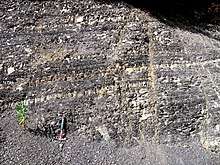Fernie Formation
| Fernie Formation (Group) Stratigraphic range: Jurassic | |
|---|---|
 | |
| Type | Geological formation |
| Sub-units | Nordegg Member, Red Deer Member, Poker Chip Shale, Lille Member, Rock Creek Member, Highwood Member, Pigeon Creek Member, Ribbon Creek Member |
| Underlies | Morrissey Formation, Nikanassin Formation, Monteith Formation |
| Overlies | Schooler Creek Group, Montney Formation, Rundle Group |
| Thickness | up to 400 metres (1,310 ft)[1] |
| Lithology | |
| Primary | Shale |
| Other | Sandstone, siltstone, limestone |
| Location | |
| Coordinates | 49°33′N 115°10′W / 49.55°N 115.16°WCoordinates: 49°33′N 115°10′W / 49.55°N 115.16°W |
| Region |
|
| Country |
|
| Type section | |
| Named for | Fernie, British Columbia |
| Named by | W.W. Leach, 1914. |
The Fernie Formation is a stratigraphic unit of Jurassic age. It is present in the western part of the Western Canada Sedimentary Basin in western Alberta and northeastern British Columbia.[2][3][4] It takes its name from the town of Fernie, British Columbia, and was first defined by W.W. Leach in 1914.[5]
Depositional history
The Fernie Formation consists of marine sediments that were deposited in the Western Interior Seaway. Deposition took place throughout most of the Jurassic period, starting during the Hettangian stage in some parts of northeastern British Columbia and continuing until the mid-Tithonian, as determined from its fossil assemblages, including ammonites, molluscs and microfossils.[3][4]
The sediments were sourced from the east during the deposition of the lower and middle units of the Fernie, where the coarser facies occur in the eastern part of the formation. In the uppermost Fernie, the coarsest material is found in the west, however, indicating a shift to sources in the west and south.[1][6]
Lithology
The Fernie Formation is composed primarily of brown and dark gray to black shales that range from massive with conchoidal fracture to laminated and highly fractured or papery. Phosphatic sandstone and limestone, including cherty limestone, occur locally in the lower parts of the formation; siltstone, sandstone, coquinas and oolitic limestone interbeds can occur in the center; glauconitic sandstone and siltstone can be present in the upper parts.[1][6]
Distribution
The Fernie Formation reaches a maximum thickness of 400 metres (1,310 ft) near Mount Allan in Alberta, and typically is about 70 to 150m (230 to 492 ft) thick. It thins toward the east, disappearing at about the longitude of Calgary. The formation is exposed in outcrops in the Kootenay region of southeastern British Columbia, in the foothills and front ranges of the Canadian Rockies in southwestern Alberta, and as far north as the Peace River Country in northeastern British Columbia.[1][6]
Relationship to other units
The Fernie Formation is conformably overlain by the Morrissey Formation in the south, by the Nikanassin Formation in central Alberta and by the Monteith Formation in northeastern British Columbia. It rests disconformably on Triassic units in the west, and unconformably on upper Paleozoic units such as the Schooler Creek Group and the Montney Formation farther east.[1][6]
Subdivisions
The Fernie Formation has the following subdivisions from top to base:
References
- 1 2 3 4 5 Lexicon of Canadian Geologic Units. "Fernie Formation". Archived from the original on 2013-02-21. Retrieved 2009-02-10.
- ↑ Mossop, G.D. and Shetsen, I. (compilers), Canadian Society of Petroleum Geologists and Alberta Geological Survey (1994). "The Geological Atlas of the Western Canada Sedimentary Basin, Chapter 18: Jurassic and Lowermost Cretaceous strata of the Western Canada Sedimentary Basin". Retrieved 2016-06-20.
- 1 2 3 Poulton, T.P., Tittemore, J. and Dolby, G. 1990. Jurassic strata of northwestern (and west-central) Alberta and northeastern British Columbia. Bulletin of Canadian Petroleum Geology 38A: 159-175.
- 1 2 3 4 5 6 7 Stott, D.F. 1998. Fernie Formation and Minnes Group (Jurassic and lowermost Cretaceous), northern Rocky Mountain foothills, Alberta and British Columbia. Geological Survey of Canada, Bulletin 516.
- ↑ Leach, W.W., 1914. Blairmore map-area, Alberta; Geological Survey of Canada, Summary Report 1912, p. 234. with Map 107A, Blairmore, Alberta, Scale: 1 inch to 2 miles
- 1 2 3 4 Glass, D.J. (editor) 1997. Lexicon of Canadian Stratigraphy, vol. 4, Western Canada including eastern British Columbia, Alberta, Saskatchewan and southern Manitoba. Canadian Society of Petroleum Geologists, Calgary, 1423 p. on CD-ROM. ISBN 0-920230-23-7.
- ↑ Lexicon of Canadian Geologic Units. "Passage Beds". Archived from the original on 2013-02-21. Retrieved 2009-02-11.
- ↑ Lexicon of Canadian Geologic Units. "Ribbon Creek Member". Archived from the original on 2013-04-13. Retrieved 2009-02-11.
- ↑ Lexicon of Canadian Geologic Units. "Green Beds". Archived from the original on 2013-02-21. Retrieved 2009-02-11.
- ↑ Lexicon of Canadian Geologic Units. "Gryphaea Bed". Archived from the original on 2013-02-22. Retrieved 2009-02-11.
- ↑ Lexicon of Canadian Geologic Units. "Corbula munda Beds". Archived from the original on 2013-02-21. Retrieved 2009-02-11.
- ↑ Lexicon of Canadian Geologic Units. "Pigeon Creek Member". Archived from the original on 2013-02-21. Retrieved 2009-02-11.
- ↑ Lexicon of Canadian Geologic Units. "Highwood Member". Archived from the original on 2013-02-21. Retrieved 2009-02-11.
- ↑ Lexicon of Canadian Geologic Units. "Rock Creek Member". Retrieved 2009-02-11.
- ↑ Lexicon of Canadian Geologic Units. "Lille Member". Retrieved 2009-02-11.
- ↑ Lexicon of Canadian Geologic Units. "Poker Chip Shale". Archived from the original on 2013-02-21. Retrieved 2009-02-11.
- ↑ Lexicon of Canadian Geologic Units. "Red Deer Member". Archived from the original on 2013-02-21. Retrieved 2009-02-11.
- ↑ Lexicon of Canadian Geologic Units. "Oxytoma Bed". Retrieved 2009-02-11.
- ↑ Lexicon of Canadian Geologic Units. "Nordegg Member". Archived from the original on 2013-02-21. Retrieved 2009-02-11.